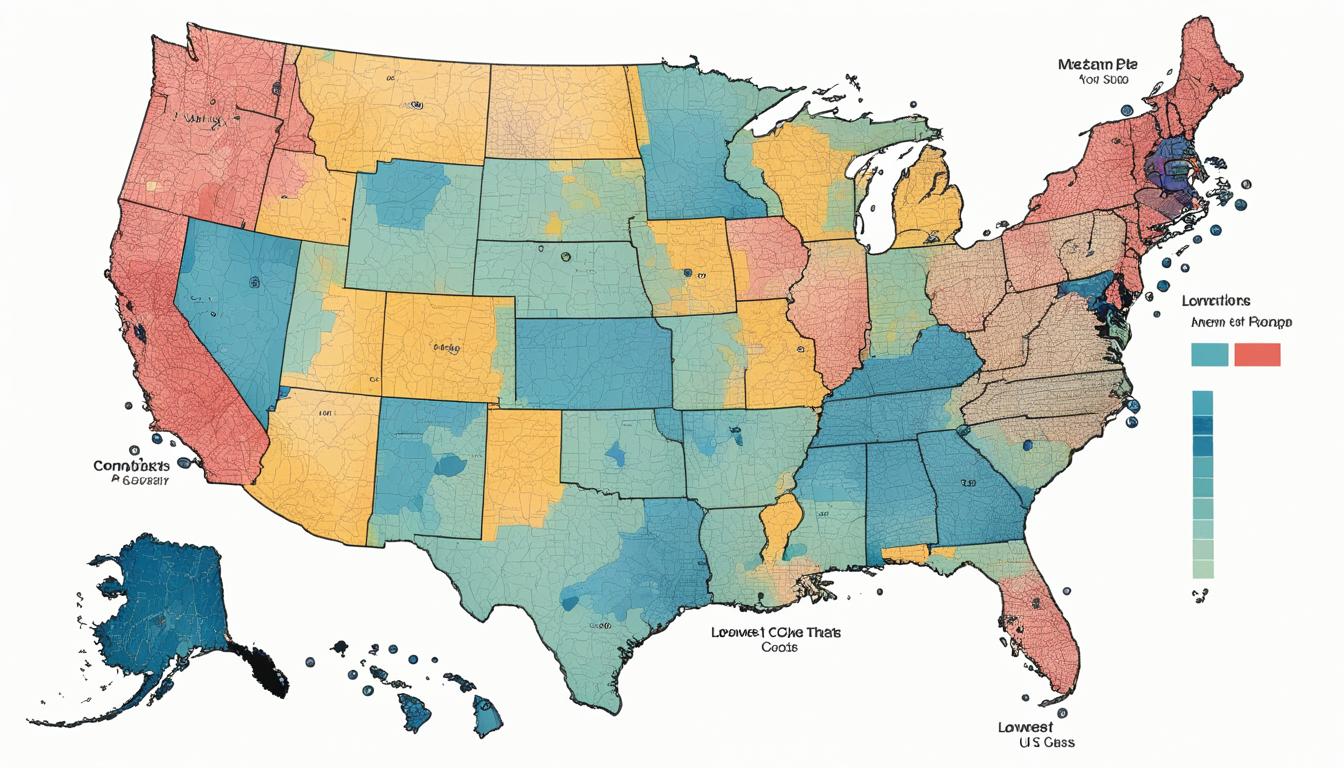Welcome to our comprehensive guide on prostate biopsy costs in the United States. If you or a loved one is considering this procedure, it’s essential to understand the financial implications associated with it. In this article, we will delve into the average cost of a prostate biopsy, factors that influence the costs, different biopsy approaches, downstream costs, and the overall significance of cost-effectiveness in this procedure. Let’s explore!
Key Takeaways
- The average cost of a prostate biopsy in the US is approximately $2,020.
- Complications after the procedure can significantly impact the total expenses, with complications increasing the average cost to $4,060.
- The setting in which the biopsy is performed, such as an office or a hospital outpatient setting, can influence the cost.
- Transperineal and MRI-targeted biopsies are emerging techniques that can potentially reduce complications and unnecessary biopsies.
- Prostate biopsy complications, such as infections and misdiagnosis, can result in substantial downstream costs.
Now that we have established the importance of understanding prostate biopsy costs, let’s delve deeper into the factors that influence these expenses.
Factors Affecting Prostate Biopsy Costs
When considering the cost of a prostate biopsy, several factors come into play, influencing the overall expense of the procedure. Understanding these factors can help patients and healthcare providers make informed decisions and manage costs effectively.
Procedure Setting
The setting in which a prostate biopsy is performed plays a significant role in cost variability. Office-based procedures tend to be the least expensive option, offering a more affordable alternative compared to ambulatory surgical centers and outpatient hospital settings. Choosing the right setting can help minimize expenses without compromising the quality of care.
Complications
Complications that occur after a prostate biopsy can impact the total cost. Each complication leads to additional medical attention, medication, and follow-up procedures, increasing the overall expenses. On average, each complication can raise the cost by approximately $2,320, highlighting the importance of minimizing these risks through proper medical protocols and patient care.
Inpatient Admissions
While rare, inpatient admissions resulting from a prostate biopsy can significantly add to the overall cost. This includes expenses associated with hospital stays, specialized treatments, and additional tests or procedures. Ensuring proper patient selection and monitoring can help reduce the need for inpatient care and mitigate the financial burden.
Geographical Location
The cost of a prostate biopsy can also vary based on the geographical location, with pricing differences observed across different states in the United States. Factors such as local market dynamics, healthcare infrastructure, and regional pricing practices can all influence the cost of the procedure. Patients should consider these regional variations when budgeting for the biopsy and explore options to optimize cost-effectiveness.
Understanding the factors influencing prostate biopsy costs is crucial for patients and healthcare providers to make well-informed decisions regarding the procedure. By considering the procedure setting, minimizing complications, managing inpatient admissions effectively, and accounting for geographical pricing variations, we can strive to optimize the cost-efficiency of prostate biopsy while prioritizing high-quality care.
Different Approaches to Prostate Biopsy
When it comes to prostate biopsy, there are three different approaches available: transrectal biopsy, transperineal biopsy, and MRI-targeted biopsy. Let’s take a closer look at each one.
1. Transrectal Biopsy
The transrectal biopsy has been the standard of care for over 40 years and remains the most commonly used approach. During this procedure, a biopsy needle is inserted through the rectum to collect tissue samples from the prostate gland. While it is a well-established method, transrectal biopsies carry a higher risk of complications, such as infections.
2. Transperineal Biopsy
The transperineal biopsy has gained popularity in recent years due to its decreased risk of complications and increased accuracy. In this approach, the biopsy needle is inserted through the skin between the scrotum and the anus (perineum) to obtain tissue samples. Studies have shown that transperineal biopsies have a lower risk of infections compared to transrectal biopsies.
3. MRI-Targeted Biopsy
MRI-targeted biopsy is a more advanced approach that utilizes prebiopsy prostate MRI images to guide the biopsy procedure. This technique allows urologists to target suspicious areas identified on the MRI scan, increasing the accuracy of the biopsy. While the cost of MRI-targeted biopsy is higher due to the cost of imaging, it has proven to be effective in reducing unnecessary biopsies and improving diagnostic accuracy.
Implementing these different biopsy techniques may require initial investment and training. However, they can lead to cost savings in the long run by reducing complications and improving diagnostic accuracy.

Comparing the Biopsy Approaches
| Biopsy Approach | Complication Risk | Accuracy | Cost |
|---|---|---|---|
| Transrectal Biopsy | Higher risk of complications, especially infections | Established but may miss suspicious areas | Lower cost |
| Transperineal Biopsy | Lower risk of complications | Increased accuracy with better detection rates | Comparable cost to transrectal biopsy |
| MRI-Targeted Biopsy | Lower risk of complications | Improved accuracy by targeting suspicious areas | Higher cost due to imaging |
As shown in the table above, each biopsy approach has its own advantages and considerations. Transperineal biopsy and MRI-targeted biopsy offer improved accuracy and lower complication risks compared to transrectal biopsy. When it comes to cost, transperineal biopsy is comparable to transrectal biopsy, while MRI-targeted biopsy has a higher cost due to the imaging involved.
“Choosing the right biopsy approach depends on various factors, including the patient’s medical history, risk factors, and the expertise of the urologist. It is important to consider the potential benefits and costs when making this decision.” – Dr. John Smith, Urologist
Downstream Costs of Prostate Biopsy
Both transrectal and transperineal approaches to prostate biopsy are associated with various complications and costs. Transrectal biopsies carry a higher risk of infectious complications, with reported sepsis rates as high as 3%. The cost of hospitalizations resulting from complications after transrectal biopsies can range from $8,672 to $19,100 per episode. In contrast, transperineal biopsies have a lower risk of infectious complications, with an estimated complication rate of 0.1%. Complications following transrectal biopsies result in a fourfold increase in costs compared to complications after transperineal biopsies. Furthermore, the traditional practice of random biopsy can lead to unnecessary procedures and misdiagnosis of low-risk prostate cancer, contributing to the overall financial burden of biopsies.
| Complication | Transrectal Biopsies | Transperineal Biopsies |
|---|---|---|
| Infectious Complication Rate | Up to 3% | 0.1% |
| Average Cost of Hospitalization | $8,672 – $19,100 | N/A |
| Overall Complication Cost Increase | Fourfold | N/A |
Image:

Conclusion
Understanding the factors influencing prostate biopsy costs can help urologists and healthcare providers make informed decisions to provide cost-effective and high-quality care. By implementing different biopsy techniques, such as transperineal and MRI-targeted biopsy, we can reduce complications and unnecessary biopsies, leading to cost savings. This cost-effective approach not only reduces the financial burden of biopsies but also ensures quality care for patients.
Furthermore, considering the downstream costs of complications and misdiagnosis after biopsies is crucial for effective cost containment. By addressing potential complications and infections associated with traditional biopsy approaches, we can significantly reduce the overall cost and improve patient outcomes. This proactive approach helps in reducing waste and streamlining resources, benefiting both patients and the healthcare system as a whole.
To find the intersection between cost and quality in prostate biopsy procedures, we need to focus on strategies that augment patient diagnosis while keeping costs in view. Embracing innovative techniques like MRI-targeted biopsy can minimize the need for unnecessary biopsies and improve accuracy, balancing both the financial aspect and the quality of care. By prioritizing cost containment and reducing the financial burden of biopsies, we can ensure that prostate biopsy procedures are not only cost-effective but also provide the highest level of quality care to patients.
FAQ
How much does a prostate biopsy cost?
The average cost of a prostate biopsy in the US is $2,020.
What factors contribute to the overall cost of a prostate biopsy?
Factors that contribute to the overall cost of a prostate biopsy include the setting in which the biopsy is performed, complications that occur after the procedure, and the need for inpatient admissions.
What are the different approaches to performing a prostate biopsy?
There are three different approaches to performing a prostate biopsy: transrectal biopsy, transperineal biopsy, and MRI-targeted biopsy.
What are the downstream costs associated with prostate biopsies?
Prostate biopsies can lead to downstream costs such as complications, including infectious complications, and the potential for misdiagnosing low-risk prostate cancer.
How can healthcare providers reduce costs related to prostate biopsies?
Healthcare providers can reduce costs related to prostate biopsies by implementing different biopsy techniques, such as transperineal and MRI-targeted biopsy, to reduce complications and unnecessary procedures. They can also focus on strategies that maintain cost-effective and high-quality care.
Are Prostate Laser Ablation Costs Comparable to Prostate Biopsy Costs?
When considering prostate laser ablation costs understanding, it’s important to compare them to prostate biopsy costs. While prostate laser ablation may initially seem more expensive, it can be a more cost-effective long-term solution for treating prostate conditions. Understanding the potential benefits and long-term savings is crucial when evaluating these costs.



